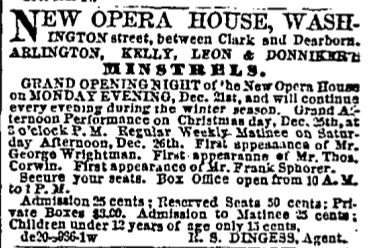*Part II of a serialized history of the influential American minstrels.
By May 1863, the Chicago Tribune described the minstrel troupe that counted Edwin Kelly and Francis Leon among their number as “a fixed fact” and observed that they were doing “the largest business ever done by a troupe of similar character in this city.” Buoyed by this success, the company made plans to construct a new theatre and, following a short summer tour, they opened at a renovated Metropolitan Hall in late September as the Arlington, Kelly, Leon, and Donniker’s Minstrels. After a successful fall season, the company moved into their new “Opera House” in late December.
- Chicago Tribune (December 1863)
While traveling companies visited Chicago on occasion during the preceding decade, it is perhaps surprising to note that up until this point the city never had a resident minstrel troupe. Kelly and Leon’s timing was auspicious insomuch as Chicago was booming during the 1860s and the ardent fashion in which the public embraced the minstrels indicated that there was a lucrative market for such entertainment in the expanding metropolis. The Tribune opined that it was “refreshing” to have a resident company “composed of gentlemen, capital singers, and fine instrumentals” given the “innumerable bands of bunglers in Ethiopian minstrelsy which have visited us.” Kelly and Leon in particular were celebrated for their talents and the Academy of Music was one the city’s premier attractions in the years that followed.
Although they obviously counted among their number some very skilled performers, there was not much that distinguished the programs of the Arlington, Kelly, Leon, and Donniker’s Minstrels from those of their contemporaries as they relied on the standard mix of singing, dancing, and comedy presented in a tripartite format. The company emphasized that they presented a refined brand of minstrelsy and even offered a Saturday matinee for “ladies and children.” They also did what they could to stay in the public’s good graces by holding frequent benefits for various charitable causes such as the Orphan’s Asylum and the Soldiers’ Families Fund. With the enthusiastic patronage of Chicago audiences and a permanent venue secured, the company worked on expanding their repertoire and mounted increasingly ambitious productions, culminating their first season with an elaborate piece called “The Sons of Malta.”*
By the end of the season, Edwin Kelly was listed as the troupe’s manager and the company was bolstered by turns from an assortment of entertainers. Perhaps the most notable of these temporary performers was Jackson Haines (1840-1875), a man who is now generally acknowledged as the father of modern figure skating. Haines was a trained ballet dancer who appeared in pantomimes during the early 1860s in New York City, but it was his ability to transpose the grace and agility of the art onto skates that made him famous. In late January 1864, he created a sensation in Chicago with his performances at Washington Park. The Tribune observed that the rolls and spins Haines executed were the “very poetry of motion” and his popularity touched off an ice skating craze in Chicago. During his May 1864 stint with the minstrels, Haines was forced to perform on roller skates, but the reviews indicate that he had lost nothing of his appeal.
The Arlington, Kelly, Leon, and Donniker’s Minstrels closed their season at the Academy of Music in late June and, following a short vacation, they toured through the Eastern cities. At some point during this tour, Donniker left the concern, which might have been either the cause or result of Edwin Kelly taking over as manager. While at the Brooklyn Athenæum in September, the Brooklyn Daily Eagle wrote that their show was “far above anything else we have seen in this line.” The newspaper described Leon as “the best Ethiopian dancer on the stage” and effusively praised Edwin Kelly’s skill, opining that there was “no signer on the minstrel stage to compare.” Kelly and Leon’s star was clearly on the rise and the company’s reputation for excellence continued to grow throughout their tour through the major Northern cities during the late summer and early fall of 1864.
* It is unclear to me whether this was a parody or adaption of a stage play called “The Sons of Malta” written by Harry Seymour that debuted at the Chatham Theater in 1857 or if it was a burlesque of the boisterous fraternal organization the Sons of Malta, which was then active in Chicago. During their 1861-1862 season, the New York City-based Bryant Minstrels presented a popular piece called “The Rugged Path, or, Sons of Malta,” that might have been the basis for the Arlington, Kelly, Leon, and Donniker troupe.
Sources: Chicago Tribune; Brooklyn Daily Eagle; Slout, Burnt Cork and Tambourines; Hines, Figure Skating.

